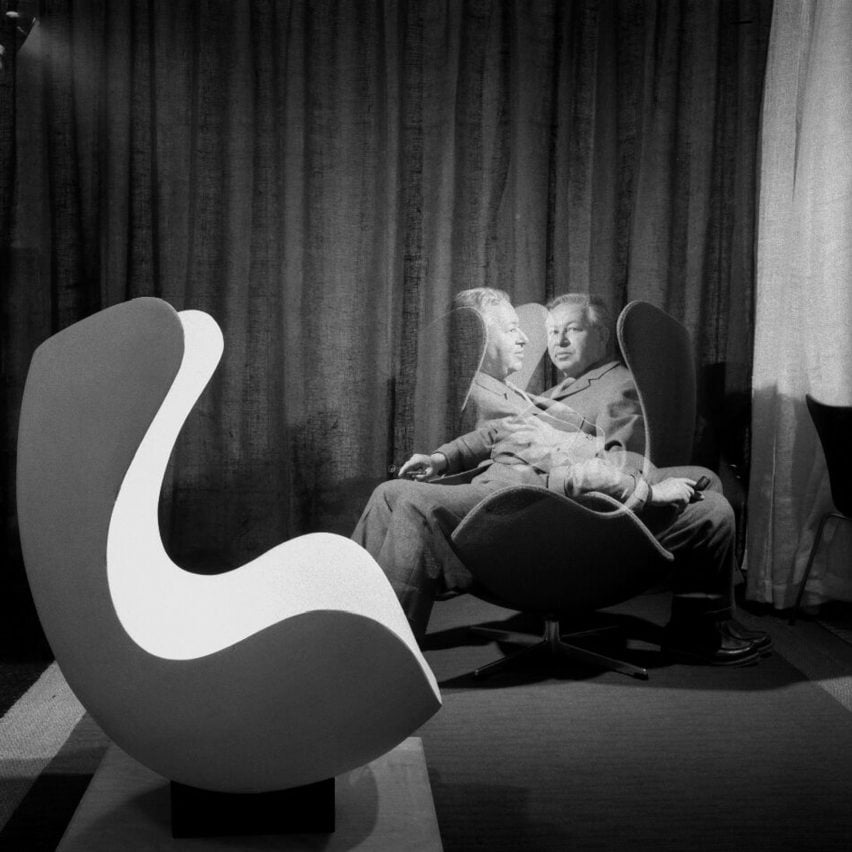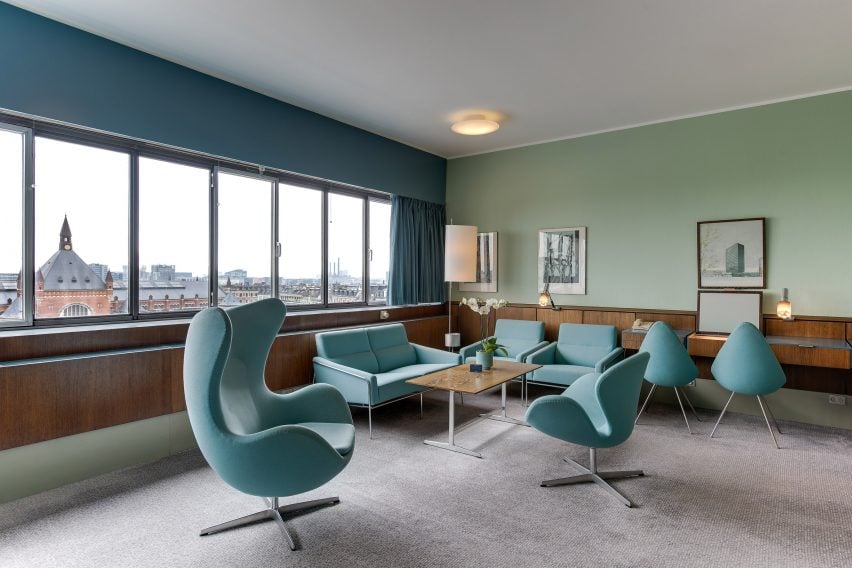Continuing our mid-century modernism series, we take a look at the iconic Egg chair, which was designed by Danish architect Arne Jacobsen in 1958 for the former SAS Royal Hotel in Copenhagen.
Characterised by an oval, upholstered main body supported by a steel insert and a four-pronged aluminium tilt and swivel base, the Egg has been manufactured by Danish furniture brand Fritz Hansen since its inception.
Jacobsen first sculpted the Egg out of hard polyurethane foam instead of shaping it around a traditional wooden or steel frame – an unconventional furniture manufacturing process for its time, positioning the chair as a historic achievement. It was subsequently upholstered in textile and leather variants.
Jacobsen was the first designer to realise its full potential, according to Arne Jacobsen Design I/S – an organisation founded to preserve the architect’s legacy – with Fritz Hansen securing the rights for the foam-based method in the mid-1950s.
The distinctively cocooning chair is considered one of the defining product designs by Jacobsen, who practised as an architect and designer until he died in 1971.
The architect conceived the original Egg in his garage, experimenting with wire, plaster and clay to devise the chair’s recognisable scooped shape. It is often said that Jacobsen’s inspiration was the 1948 Womb chair, designed by his contemporary, architect Eero Saarinen.

Christian Andresen, design director at Fritz Hansen, reflected on the significance of the Egg, which highlights a post-war trend in the international design scene when European and American architects began to favour organic shapes crafted from novel materials.
“Jacobsen dared to work with modern materials and was curious about technology and industrial manufacturing, unlike some of his peers who were still focussed on the traditional way of making furniture,” he told Dezeen.
“A key characteristic of Jacobsen was his ability to convert his artistic belief in furniture into all of his designs,” added the design director.

Born in Copenhagen in 1902, Jacobsen is remembered as a pioneer of Danish modernism, with a particular focus on projects that combined his architecture and design.
Among these is Copenhagen’s SAS Royal Hotel – today, the recently listed Radisson Royal Collection Hotel – constructed as a hotel-cum-airport terminal for Scandinavian Airlines in 1960. Jacobsen meticulously designed every component of the building, from its rectilinear aluminium and glass facade to the restaurant’s stainless steel cutlery and porcelain blue ashtrays.
One of these designs was the Egg, first created for the hotel lobby in 1958 alongside its sister chair the Swan. The generous curves of the furniture were designed in direct contrast to the hotel’s strict geometric architecture.

“Jacobsen had a clear and uncompromising style when designing architecture and a very emotional and organic approach to interiors and the furniture in his projects,” considered Andresen. “This was probably uncommon in the 1940s and 50s, making him unique.”
“The Egg created an intimate, almost enclosed space, while simultaneously allowing its occupants to swivel around and follow the buzz of the hotel reception,” he added.
“Jacobsen often put two to three chairs in a circle to create a bouquet of chairs in an often rigid and structured space, creating an oasis in the room.”

Dominic Bradbury, author of the 2022 book Mid-Century Modern Furniture, agrees. “The Egg famously provides an enveloping and secure space within a space,” he wrote.
In 1958, both the Egg and the Swan were met with positive reviews, highlighting the instant popularity of Jacobsen’s modern design approach.
“There was a major do at Fritz Hansen’s furniture factory yesterday – almost like a catwalk show with spotlights, flash photography and VIP guests,” reported Danish newspaper Politiken shortly after the furniture launched.

While the interior of the Radisson Royal Collection Hotel was redesigned, a singular room – number 606 – has been preserved with its original interiors, showcasing the Egg as Jacobsen first intended.
Since its creation, the Egg has remained a design classic, not only in luxury environments. The chair’s more unusual settings have ranged from the diary room of the first UK series of reality TV show Big Brother in 2000 to European branches of fast food chain McDonald’s.
Despite its consistent appearance, the Egg’s manufacturing process has undergone four main changes over the years, and “loads of small constructive updates”, said Andresen.
“We are constantly looking for new ways of fine-tuning,” he explained.
In the 1960s, Fritz Hansen switched from hard to moulded foam and reinforced the chair with fibreglass. However, fibreglass was phased out in the 1980s, when Fritz Hansen switched to a different type of foam, according to the design director.
“Fibreglass is not very sustainable because it creates a composite construction that cannot be recycled,” considered Andresen. “Today, we manufacture the chair in a unique construction of moulded hard and soft foam surrounding the steel inner structure.”

“This ensures a very high level of durability and firm stability. The chair also now has no glue or composites, enabling disassembly and recycling,” he added.
Despite these shifts in manufacturing, the Egg has retained its foam body, steel insert and upholstery since 1958.
“We still sow the textile and leather variants by hand so the final finishing has not changed since the beginning,” added Andresen. “This also means that the chair can be reupholstered if the surface gets damaged or worn out.”
“The Egg chair was, and still is, an iconic sculptural shape and a unique design,” concluded the design director. “I think the organic, simple and elegant shape is like a sculpture in a room. It can stand by itself and create a space around it, appearing beautiful from all sides.”
The photography is courtesy of Fritz Hansen unless stated otherwise.

Mid-century modern
This article is part of Dezeen’s mid-century modern design series, which looks at the enduring presence of mid-century modern design, profiles its most iconic architects and designers, and explores how the style is developing in the 21st century.
This series was created in partnership with Made – a UK furniture retailer that aims to bring aspirational design at affordable prices, with a goal to make every home as original as the people inside it. Elevate the everyday with collections that are made to last, available to shop now at made.com.

